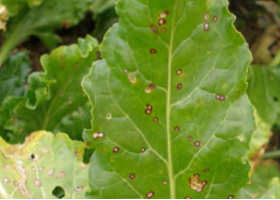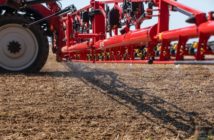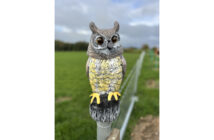Darryl Shailes, root products technical manager with crop production specialist Hutchinsons, highlights why Cercospora is becoming an increasingly difficult to control disease in sugar beet and how growers can improve their understanding of the disease and control it.
Until 2020 apart from a few isolated incidents of Cercospora (Cercospora beticola) on the Suffolk coast, disease control in the UK sugar beet crop, centred around powdery mildew (Erysiphe betae) and rust (Uromyces beticola), with rust becoming the dominant disease in recent years.
2020 changed all that when plants already weakened by virus yellows became heavily infected with Cercospora, causing a dramatic effect on the foliage and hence yields.
This was not only due to the weather conditions that summer, hot days, and nights with thunderstorms causing plenty of leaf wetness and humidity vital for Cercospora infection, but also the chemistry that we had relied on for several years only being partially effective against the disease.
In 2020 Cercospora started to be reported in late August and by October many crops were very badly affected with considerable leaf loss and hence yield.
Cercospora is the number one disease in most of the sugar beet growing areas and is generally resistant to strobilurins and shows some insensitivity to triazoles.
The chemistry used in 2020 was solely strobilurins and triazole-based which were generally applied at the onset of disease normally around mid to end of July and then again, a month or so later for later lifted crops. Some crops destined for lifting after Christmas would receive another treatment.
This programme controlled rust and mildew very well initially, but towards the end of August fungicides were running out of steam and coupled with very wet hot days and nights, created conditions perfect for the development of Cercospora.
We had a perfect storm with little or no protection and Cercospora running rife.
To add to the challenge, there was very little information around variety resistance to Cercospora, unlike rust and mildew which where were on the variety data on the BBRO Recommended List (British Beet Research Organisation).
In the rest of the world where Cercospora is the number one disease, strategies for control were completely different. Non strobilurin-based fungicides were applied much more frequently with up to 7 applications being made in some seasons and with much shorter intervals.
The chemistry was based on contacts such as mancozeb which is not approved on sugar beet in the UK and other classes of fungicides which are no longer available in the UK and Europe. Triazoles are also alternated to reduce the build-up of insensitive isolates in season. In parts of Europe copper-based fungicide have been given emergency approvals for use in sugar beet specifically for Cercospora control.
Also, more was known about the disease and varietal resistance to the disease was better, such as the more KWS CR+ varieties with decision support systems to guide the timing of fungicide input widely adopted.
To sum up, Cercospora is in an increasingly challenging cycle with less chemistry available, pressure on the fungicides leading to less effective control, build-up of Cercospora inoculum in the background and so it goes on.
That coupled with the increasing temperature we seem to be experiencing in the UK means that now we are at high risk of an issue depending on the weather.
So, what has changed since 2020.
Number 1 we are now very aware of the potential for a Cercospora infection.
The BBRO launched a warning system in 2021 based on models used in other countries such as the USA and Spain where Cercospora risk is very high and issue warnings when an infection period in likely.
This is based on the interaction of temperature and humidity and estimates a daily infection value (DIV). This enables growers and agronomists to maintain a sufficient level of fungicide in the leaf when the weather is suitable for infection and the risk is high. Research has suggested that crops are particularly at risk when the interval between applications is too long, and the fungicide has run out of steam in high pressure situations.
Cercospora ratings are now included in the BBRO Recommended List. Although the variation around the mean in the 2023 RL of 6.9 doesn’t vary as much as the ratings for mildew and rust, it does provide some indication of varietal susceptibility.
So where does that leave us managing foliar disease in 2023?
We have a lot more information available to us now than we did historically. However, this is only useful if acted upon, so it’s important that everyone involved in the decision making on the farm has access to what is needed.
Signing up to the BBRO newsletter and alerts is vitally important. Don’t just leave it to the agronomist as they may be on holiday and in beach mode. Also, August which is when we had the problem in 2020, is a very busy period of work so attention is not always on the beet crop.
Removing all forms of potential inoculum is very important, beet tops and spoil heaps may still be a risk factor. With the busy spring and summer, this may not have happened.
Whilst rust and mildew are pretty obvious Cercospora can be confused with other leaf spots
Look for circular spots 3-5 mm in diameter with tan-grey coloured centres with a reddish-brown border. Spots grow and coalesce causing sever leaf loss.
Then decide on the fungicide strategy.
Mefentrifluconazole + fluxapyroxad has just been approved and will be the strongest product against Cercospora that we currently have available.
Other products that we have are difenoconazole + azoxystrobin, flutriafol, sulphur and prothioconazole + fluopyram which can only be applied from September 1st.
For rust and mildew the standard practice of applying a broad-spectrum product at the first signs of disease or when reported locally should still be sufficient. Trials have shown that even in the absence of disease all crops benefit from at least one broad spectrum fungicide with a yield lift of around 5% due to the leaf greening effect they have.
Products choice should be based on discussion with the agronomist or BBRO from the list above considering disease pressure, variety and lifting date.
September lifted crops will generally only require one broad spectrum treatment. Those lifted mid-October crops will require 2 and those to be lifted after Christmas may benefit from 3 or more applications.
The main thing is know what’s going on in the crop , keep up to date with the BBRO disease alerts and don’t let the gaps stretch too long between treatments where Cercospora risk is high.




